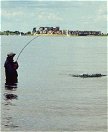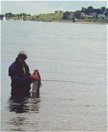
Fishing surface flies for striped bass ranks as one of the sport's great thrills and can also be extremely productive at times when no other fly seems to work. Learn how in this excerpt from Jack's book, Striper Strategies.
Types of Surface Flies
There are four main types of surface flies in common use among striped bass fishermen: Poppers, Gurglers, Sliders, and Floating Baitfish Imitations. The first three types are generally considered attractor types, while the fourth, Floating Baitfish Imitations, are usually just that, more detailed and "realistic" floating imitations of baitfish.
Poppers
 Poppers,
with their scooped-out faces, are designed to attract fish by producing
sounds and "commotion" when worked in the water by the angler. Of
all the surface flies, poppers produce the most noise, the most
commotion. They are extremely effective at times when fish are actively
feeding on baitfish close to the surface and are also very effective
as well in drawing fish up from the depths to "have a look," perhaps
having been deceived by the sounds into thinking that baitfish are
splashing around on the surface. Poppers can be made up in many
sizes and colors from the small pencil poppers, which range in size
generally from 1"-3," to the very large poppers which may measure
up to 5". A good general rule when it comes to deciding on how large
a popper to use (this tip was passed on to me by my friend, Ed Hawley)
is that the deeper, darker, and rougher the water the larger the
popper - to draw fish up from a greater depth. Although poppers
are frequently fished in many different colors, I've never noticed
the fish showing a preference for one color over another. I usually
fish only two colors, all-black or all-white, and find that one
of these will generally produce under a wide variety of circumstances.
Poppers,
with their scooped-out faces, are designed to attract fish by producing
sounds and "commotion" when worked in the water by the angler. Of
all the surface flies, poppers produce the most noise, the most
commotion. They are extremely effective at times when fish are actively
feeding on baitfish close to the surface and are also very effective
as well in drawing fish up from the depths to "have a look," perhaps
having been deceived by the sounds into thinking that baitfish are
splashing around on the surface. Poppers can be made up in many
sizes and colors from the small pencil poppers, which range in size
generally from 1"-3," to the very large poppers which may measure
up to 5". A good general rule when it comes to deciding on how large
a popper to use (this tip was passed on to me by my friend, Ed Hawley)
is that the deeper, darker, and rougher the water the larger the
popper - to draw fish up from a greater depth. Although poppers
are frequently fished in many different colors, I've never noticed
the fish showing a preference for one color over another. I usually
fish only two colors, all-black or all-white, and find that one
of these will generally produce under a wide variety of circumstances.
Poppers may be fished in many ways, with lots of frenetic motion and commotion generated and accompanied by some energetic rod action, or more slowly, with only intermittent pops produced largely by the line hand. Or the popper may be fished using a combination of actions and retrieves and rhythms (the spaces, or pauses, between movements). Experiment with different methods of fishing a popper to discover the most productive strategies at the time you're fishing. If you've never fished a popper before, you might want to watch and learn from a proficient plug-caster or spin-fisherman as he works his popper across the surface.
When fishing an estuary with lots of undercut banks, you might want to approach the situation in much the same way as you would when fishing for largemouth bass, by casting in close to the bank or behind rocks or into other areas where stripers may hold, and then slowly working your fly along or away from the bank. Blind casting with poppers along a beach or up against breakwaters or rocky shores can also be very productive at times.
Sliders
 A
slider is an attractor fly designed to be fished on the surface
with a minimum amount of commotion. Quite unlike the popper, it's
designed to appeal to stripers that may be inclined to feed on the
surface but which are more wary and less eager to take a noisier
popper. If you find, for instance, that fish are coming up for your
poppers but are turning away from them at the last moment, you should
consider using a slider instead. There are many slider-type flies
available to the angler, but I prefer to use a simple one of my
own devising (see above).
A
slider is an attractor fly designed to be fished on the surface
with a minimum amount of commotion. Quite unlike the popper, it's
designed to appeal to stripers that may be inclined to feed on the
surface but which are more wary and less eager to take a noisier
popper. If you find, for instance, that fish are coming up for your
poppers but are turning away from them at the last moment, you should
consider using a slider instead. There are many slider-type flies
available to the angler, but I prefer to use a simple one of my
own devising (see above).
Gurglers
 The
Gurgler is a surface commotion fly that was designed to produce
a disturbance less noisy than the popper but louder than the silence
of a slider (I figured that in this middle ground would lie an opportunity
to attract those fish that weren't especially turned on by either
the Popper or Slider.) When tied and fished correctly, the Gurgler
produces a "gurgling" sound that I've found much more consistently
appealing to the stripers than the popper and is generally my first
choice for a surface fly.
The
Gurgler is a surface commotion fly that was designed to produce
a disturbance less noisy than the popper but louder than the silence
of a slider (I figured that in this middle ground would lie an opportunity
to attract those fish that weren't especially turned on by either
the Popper or Slider.) When tied and fished correctly, the Gurgler
produces a "gurgling" sound that I've found much more consistently
appealing to the stripers than the popper and is generally my first
choice for a surface fly.
Floating baitfish Imitations
 Floating
baitfish imitations are surface flies that more closely imitate
an actual baitfish than do either a popper, slider or gurgler. These
flies are very useful when a more realistic surface imitation is
called for. Examples of some handy and effective floating baitfish
imitations are the Floating Minnow (above) and the Floating Sand
Eel.
Floating
baitfish imitations are surface flies that more closely imitate
an actual baitfish than do either a popper, slider or gurgler. These
flies are very useful when a more realistic surface imitation is
called for. Examples of some handy and effective floating baitfish
imitations are the Floating Minnow (above) and the Floating Sand
Eel.
When to Fish Surface Flies
 The
most obvious time to use a surface fly is when stripers are visibly
feeding on baitfish close to the surface. This is when they're most
likely to take a fly that is enticingly fished on or close to the
surface.
The
most obvious time to use a surface fly is when stripers are visibly
feeding on baitfish close to the surface. This is when they're most
likely to take a fly that is enticingly fished on or close to the
surface.
Even if you don't see stripers working on the surface, you might want to consider using a surface fly whenever the surface is calm. This is an especially propitious time to work a surface fly, especially a "commotion" fly like a popper or Gurgler, both of which can attract fish over a great distance. I've caught some very large stripers when fishing a popper or Gurgler over a calm, unruffled surface when no stripers were showing anywhere.
The Gurgler makes an excellent "searching" fly when fishing in shallow water (generally four feet or less), where you can frequently attract a striper to the surface even if it's not visibly feeding there, even if there are no baitfish visible. Gurglers and poppers are also especially effective as searching flies when fishing at night. The commotion, sounds and vibrations produced by these flies will attract fish from quite a distance.
Estuaries are also excellent places in which to work a surface fly. They are often of a depth well-suited for a surface fly (being relatively shallow, relative to the ocean's depths, that is) and contain large numbers of cruising, shallow-water or topwater-oriented baitfish that have entered (or taken up residence) in the relatively calm, relatively secure, and relatively food-rich estuary. All things being relative, of course.
One of my favorite places to fish a surface fly, in fact, is in an estuary that flows through an industrial area and out into Boston Harbor. Surface fishing for stripers in this particular place is so predictably good that I now go there only to fish surface flies. No matter what the weather, or whether or not there are baitfish showing, the fish seem always to show an unusual interest in a well-fished surface fly, most often a Gurgler. But only in one particular area and only for about an hour or two either side of low tide. Knowing this I can now just look at a tide table and be there at the right time and in the right place to expect often spectacular action on the surface.
Surface flies are also very effective when the tide is slack, either high or low. At such times you generally want to work your fly very slowly along the banks or the edges of drop offs or among any structure that might be visible and that's likely to attract stripers.
How to Fish Surface Flies
 As
it is with fishing any type of fly, the most effective ways of fishing
a surface fly will depend on many factors. Whether the fish are
actively feeding, whether they are cruising or holding, whether
the tide is running strong or weak, whether the water is deep or
shallow, and so forth. And as always, the most important thing an
angler can do is to experiment with different types of surface flies
and with different methods of retrieves.
As
it is with fishing any type of fly, the most effective ways of fishing
a surface fly will depend on many factors. Whether the fish are
actively feeding, whether they are cruising or holding, whether
the tide is running strong or weak, whether the water is deep or
shallow, and so forth. And as always, the most important thing an
angler can do is to experiment with different types of surface flies
and with different methods of retrieves.
Poppers
I don't fish poppers as much now as I used to before I designed the Gurgler, a surface fly that does much of what I used to do with poppers. When I do fish a popper these days it's usually a fairly large popper, 3" - 4" long from stem to stern. It's a bear to cast but can often bring to the surface or attract some very large stripers that might not otherwise be tempted by a quieter and smaller Gurgler. I tend to fish large poppers most frequently when stripers are feeding on larger baitfish such as pogies or herring or when working over deep water.
Most often I fish these poppers very quickly, pumping my rod in short, rhythmic strokes and retrieving my line in time to the rhythm set by the rod. At times I'll fish the popper with very short or small movements, only 2" - 3" with barely a pause between strokes; at other times, the movements will cover more distance, 6" - 12" with a longer pause between movements. Each movement, however, will produce a fairly loud "pop," to attract fish from a distance. If I'm fishing a fairly short line, say forty feet or less, I sometimes also like to hold my rod tip high and "skip" the popper (with a lot of rod action) across the surface, only occasionally "popping" it. This skipping and skittering motion can be an especially deadly way to fish a popper.
Gurglers
The Gurgler is the surface fly I most frequently fish and is the first one I'll tie on when I think I might get some surface action. My favorite is a White Gurgler in sizes #2- 1 /0 (long shank), #2 when smaller fish are abundant and #1 or #1/0 when larger fish looking for larger mouthfuls are in the area. Other colors – black or olive or blue/ white – can also be useful at times but plain white has been the most productive color. I sometimes also vary the height of the "lip" to produce different intensities of sound, leaving it high when I want a more pronounced gurgle, and trimming it a bit shorter when I want it to produce a more subtle sound.
My methods for fishing the Gurgler vary according to circumstances. If fish are showing on the surface I like to cast as close to them as possible and work the fly fairly slowly with 3" - 5" twitches with a significant pause between strips, trying to keep the fly in the general area of the feeding fish for as long as possible. If no fish are showing, I prefer to work the fly quite a bit more quickly, with 6" - 8" twitches with only a short pause between them. This retrieve seems to work most consistently. Sometimes, however, the fish will prefer a very slowly worked fly and when they do I oblige them. The key to fishing the Gurgler (as with any fly) is to experiment with different retrieves until you come upon one that works consistently at the time and in the circumstances you're fishing.
Two tricks that may bring more fish to your hand are worth mentioning here. When I want to give the fly a more pronounced "wounded minnow" action, I'll turn it on its side, twisting the body slightly and offsetting it on its shank so that the fly dances this way and that with sideways motion as it comes across the surface. This change in the action of the fly can sometimes be deadly. Another trick that can be very productive at times is to fish two Gurglers at a time. When I do this, I fish one very small Gurgler, a #6 for example, behind a fairly large Gurgler, a #1 or #1/0. 'Me smaller fly is joined to the bend of the larger one, with about eight inches between them. When fishing tandem flies, I tend to fish the flies fairly slowly but with significant gurgle. You may also want to try attaching a small baitfish imitation to the bend of the Gurgler. This can also produce some interesting results.
Sliders
If you find stripers coming up to your popper or Gurgler and then refusing to take it or turning away at the last minute, you may take this as a cue to switch to a Slider, a much quieter fly that stripers at times find much more attractive than a noisier fly. Fish it slowly and swim it smoothly over feeding fish or fish it as a quiet attractor fly in clear, calm water. Vary your retrieve speeds and your rhythms - and see what happens. Sometimes an exceptionally fast retrieve, as fast as you can possibly retrieve it, will induce some ferocious surface action.
Floating baitfish imitations
There are times when surface-feeding stripers will key in on certain baitfish and will refuse to take a more general or impressionistic surface fly. At these times I'll tie on a floating baitfish imitation that more closely resembles the food being fed upon. Whether this fly will imitate a silversides, sand eel, or some other baitfish, I'll generally fish the fly very slowly, as often as not just under the surface as well as upon the surface (I can control the float-rate by using either more or less foam or a heavier or lighter hook.) When fishing a current and there are stripers feeding, I like to cast the fly upstream of the feeding fish and then to dead-drift it floating down to them, twitching the fly slightly as it approaches, to attract their attention. If no fish takes, and when the fly is below me and begins to swing in the current, I'll tease it back towards me and cause the fly to dip below the surface and then to rise again, very like a wounded minnow. This is a very effective strategy whether fish are showing or not. When fishing a flat or a pond or other body of water without a strong current, I'll work the fly slowly just under the surface, again using small twitches – or, if more regular action is called for, using long, slow, regular arm movements as I retrieve the fly (sometimes even waving my rod back and forth in front of me to cause the fly to dart this way and that). Other slow wounded-minnow-like retrieves can also be effective and should be experimented with to discover which one works best in a particular situation.






